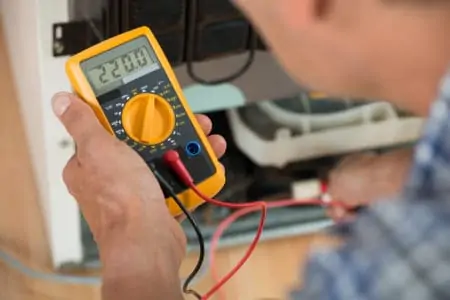Whether you are a DIY enthusiast or a professional, a multimeter is invaluable. It’s the best way to measure voltage, current, and resistance when diagnosing electrical issues.
We scrutinized the widest choice of multimeters, rating them on their performance, cost, specific uses, and capabilities to bring you our favorite 10 models.
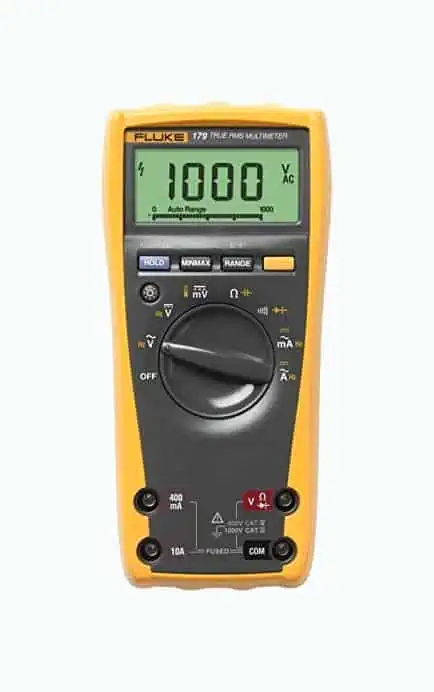
- True RMS for accuracy when measuring AC
- CAT IV and CAT III Tested
- Temperature range of -40 to +400 c
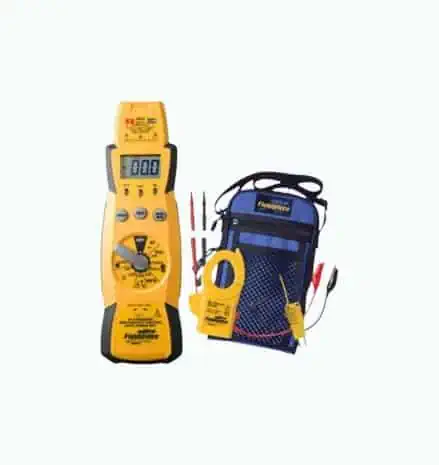
- Designed for HVAC systems
- Expandable range testing stick
- Measures VAC, VDC, AAC, ADC, and capacitance
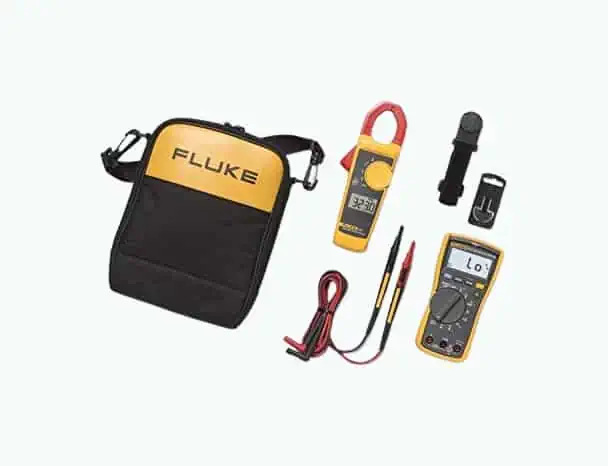
- Complete kit for every electrical need
- True RMS for better accuracy
- CAT III 600V safety rated
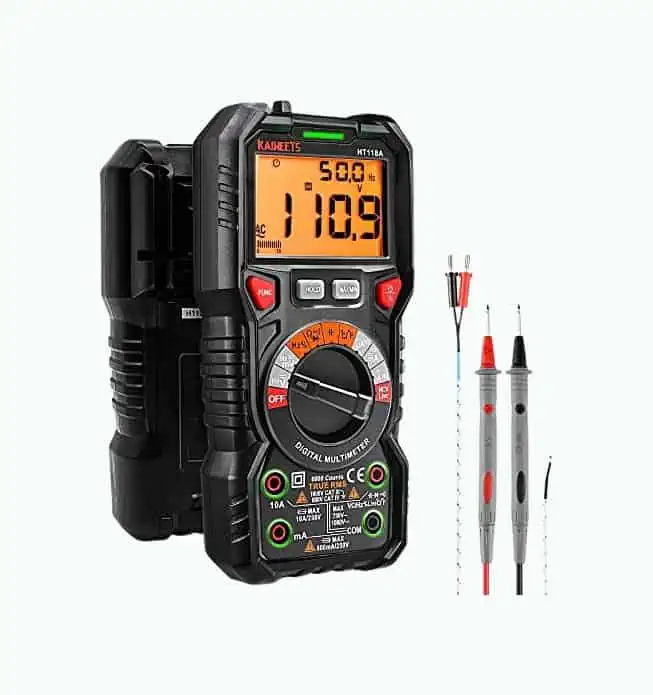
- Incredible price with so many functions
- True RMS for better accuracy
- CAT III 1,000V and CAT IV 600V safety rated
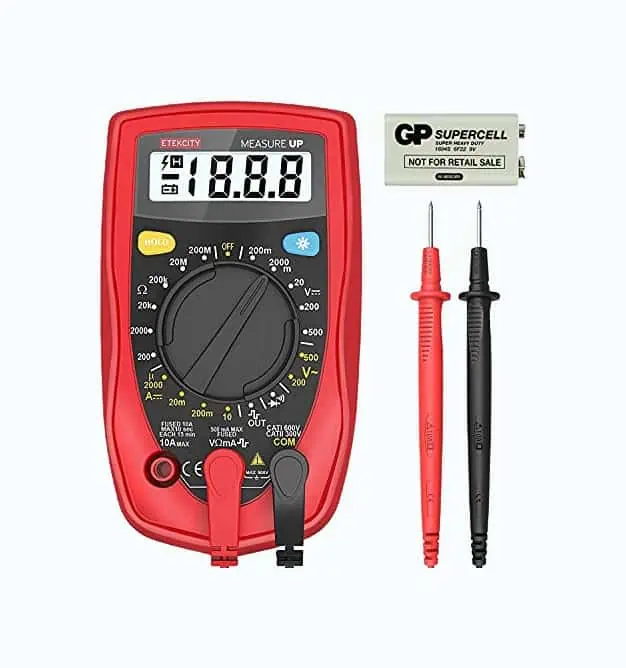
- Test AC and DC voltage, as well as DC
- Unbelievable price makes it ideal for beginners
- Large backlit display
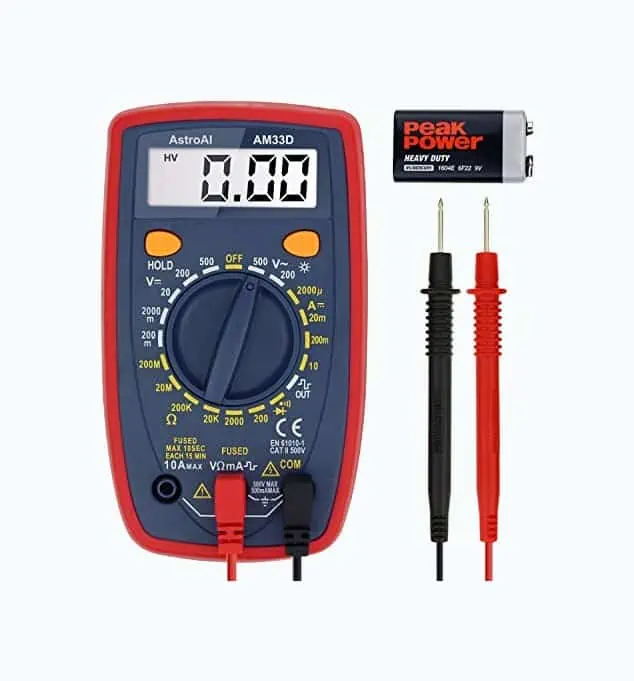
- Test AC and DC voltage, as well as DC
- Unbelievable price
- Large backlit display
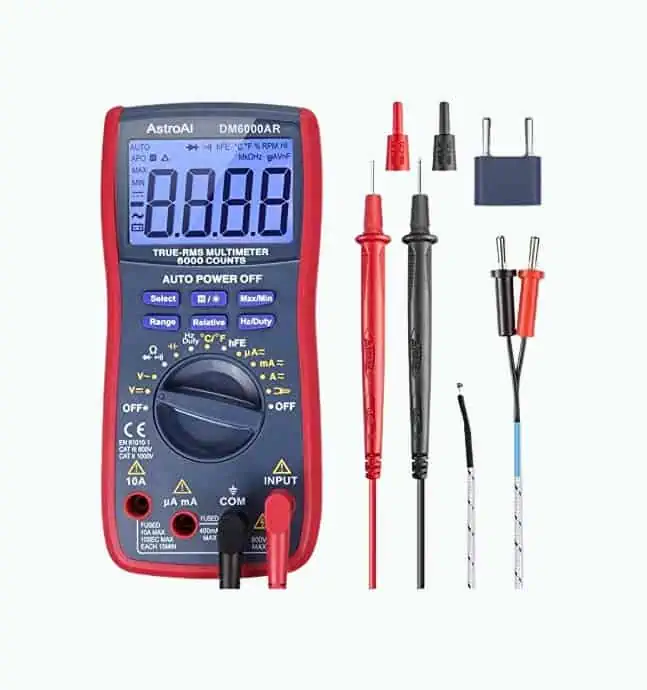
- Test AC and DC voltage, as well as DC
- Great all-around multimeter
- Large backlit display
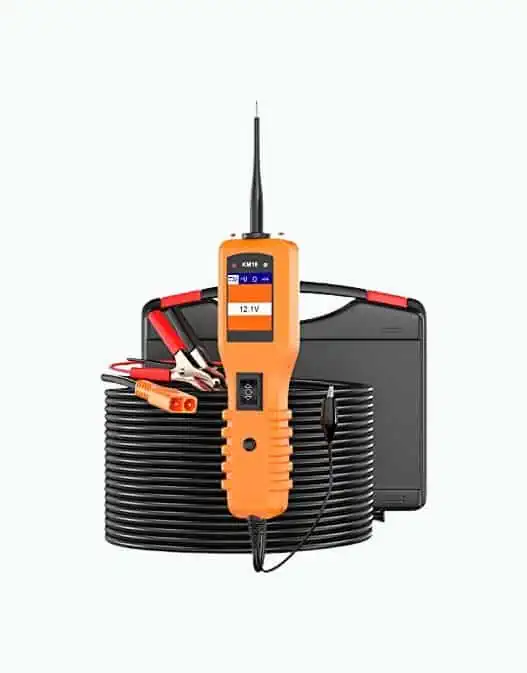
- Tests all 12V and 24V systems
- Has an extension lead that reaches around your vehicle
- Has a diagnostic and multimeter setting
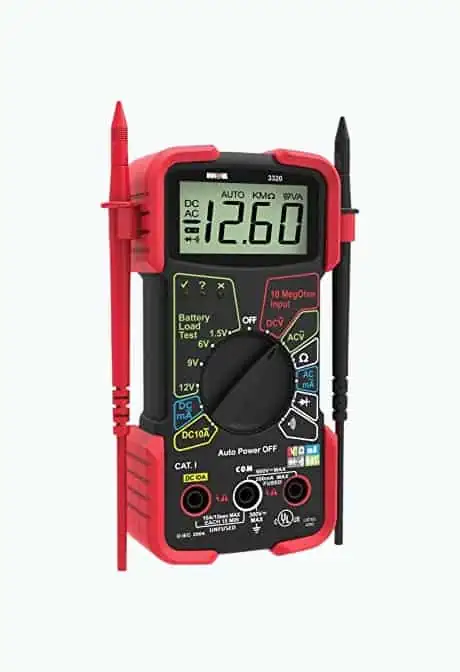
- Auto-ranging for the simplest operation
- Ideal for beginners to learn with
- Color-coded and an easy-to-read display
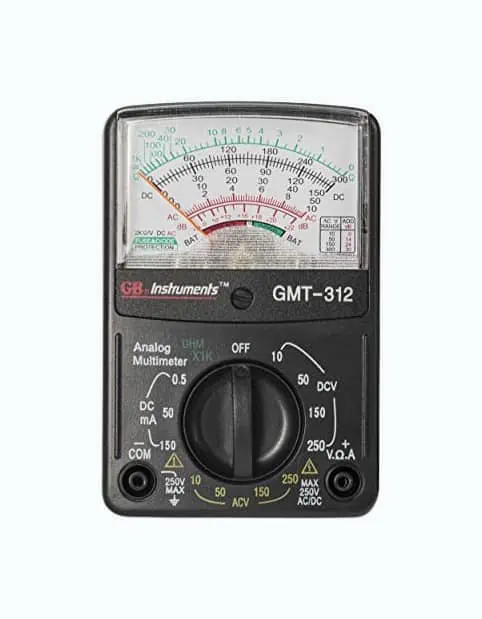
- Manual dial is clear and easy to read
- Robust analog design
- Accurate to within plus or minus 5 percent
Review Methodology: At Sensible Digs, we believe in providing you with in-depth analysis and assessment of the best multimeters. Our experienced professionals rigorously test each product, benchmarking and comparing them based on key decision-making factors such as performance, design, and ease of use. We use hands-on evaluations and quantitative measurements to rank these multimeters. Our reviews are supported by facts and first-hand evidence, detailing what sets each product apart. Our goal is to guide you through your purchasing process with reliable data and our practical experience, ensuring you make a sensible choice.
The Best Multimeters of 2024
Trying to find the 10 best multimeters is a challenge, especially as there are so many to choose from. We rated our top choices based on customer feedback, performance, and specific uses.
Fluke 179 ESFP True RMS Multimeter
Best Premium Multimeter
If it’s a premium multimeter, it had better be good. After all, what are you paying the price for? This Fluke 179 ESFP is one of the best multimeters money can buy and a must for professionals.
It has 1,000V AC/DC, 10A AC/DC, and it comes with the test leads and jacks. It has a resistance of 50MΩ and a temperature range of -40 to +400 degrees Celsius.
This model has manual and automatic ranging, so you can switch between the two, display hold, auto hold, and a minimum and maximum average recording. There is a backlit display with an analog bar graph and built-in temperature with an included thermocouple.
This multimeter has been tested for safe use in CAT IV 600 and V/CAT III in 1,000V environments. This is a True RMS model, which is more accurate than the RMs versions when measuring AC.
It is an excellent device, but you have to question if it is worth the price tag, given it costs several times more than comparable models.
Pros
- True RMS for accuracy when measuring AC.
- CAT IV and CAT III Tested.
- Temperature range of -40 to +400 C.
- Minimum and maximum voltage recording.
Cons
- It costs several times the amount of comparable models.
Product Specs
| Weight | 2.20 pounds |
| Tested | CAT IV and CAT III |
| True RMS | Yes |
| Resistance | 50MΩ |
| Price | $$$$$ |
| Warranty | Lifetime |
Our Ratings
User Experience
Fieldpiece HS33 Expandable Manual Range Stick Multimeter
Best HVAC Multimeter
The HS33 is specifically designed to measure HVAC parameters, including temperature with quick compensation via a K-type plug, a diode test, and a built-in non-contact voltage tester. The ergonomic shape fits the contours of your hand to make it as comfortable as possible to hold.
You also get a magnetic hanger and an alligator clip for hands-free testing. It has ranges that include VAC, VDC, AAC, ADC, and temperature, plus capacitance.
You also get high voltage and continuity indicators and an expandable range testing stick favored by students of stick meter schools. The only minor point is this is a manual HVAC multimeter, and the screen is not backlit.
Also, the HS33 is not a True RMS model, so it might be less accurate than other True RMS versions.
Pros
- Specifically designed to measure HVAC systems.
- Expandable range testing stick for pinpoint accuracy.
- Measures VAC, VDC, AAC, ADC, and capacitance.
- Ergonomic design for comfort and grip.
Cons
- Non-backlit screen makes it harder to read.
- Not a True RMS model.
- Manual ranging reduces some accuracy.
Product Specs
| Weight | 1.5 pounds |
| Tested | CAT II and CAT IV |
| True RMS | No |
| Resistance | 200MΩ |
| Price | $$$ |
| Warranty | 1-year |
Our Ratings
Personal Perspective
Fluke 117/323 Electricians Multimeter Kit and Clamp Meter
Best Multimeter for Electronics
If you are an electrician, this multimeter kit will prove invaluable. It measures AC and DC voltage as well as AC and DC amps, plus the 323 clamp meter measures AC and DC voltage as well as AC amps.
This is a True RMS device, giving you accurate measurements on non-linear loads. It has a low input impedance to avoid ghost voltage, which occurs when non-energized and energized circuits are in close proximity.
You also get minimum and maximum averages with elapsed time to record signal fluctuations, and this model is CAT III 600 V safety rated.
It also has VoltAlert technology for non-contact voltage detection and automatic AC and DC voltage selection. While this is a complete kit, it costs almost as much as the premium model, so you would only buy this if you had a specific electrical need.
Pros
- Comes as a complete kit for every electrical need.
- True RMS for better accuracy.
- CAT III 600V safety rated.
- Automatic ranging between AC and DC.
Cons
- Costs almost as much as the premium model.
- Suitable for professionals only.
Product Specs
| Weight | 1.76 pounds |
| Tested | CAT III |
| True RMS | Yes |
| Resistance | 4kΩ |
| Price | $$$$ |
| Warranty | 90 days |
Our Ratings
Community Feedback
KAIWEETS Digital Multimeter
Best Auto-Ranging Multimeter
Apart from the attractive price tag, this KAIWEETS has 6,000 counts auto-ranging for accurate measurements of AC and DC voltage and AC and DC. It also measures resistance, capacitance, continuity, frequency, and diode.
While auto-ranging is not unique to this multimeter, it is a feature of this model, even with the low price.
With such a varied array of capabilities, you can use it in the auto industry and commercial and household settings. It has a backlit dual display with a bar graph, LED lighting jacks that help you place the probes correctly, and a flip-out table stand for hands-free operation.
It is CAT III rated at 1,000V, and CAT IV rated at 600V, and it measures resistance between 30Ω and 60Ω. This compact and affordable multimeter is also True RMS, making it super-accurate.
According to some customers, the backlit display stays on for a short time then goes off, and the meter uses a lot of battery power, meaning you will have to change them regularly.
Pros
- Incredible price with so many functions.
- True RMS for better accuracy.
- CAT III 1,000V and CAT IV 600V safety rated.
- Automatic 6,000 count ranging between AC and DC.
Cons
- The backlit screen turns off too frequently.
- Batteries don’t last very long.
Product Specs
| Weight | 1.36 pounds |
| Tested | CAT III and CAT IV |
| True RMS | Yes |
| Resistance | 30Ω to 60Ω |
| Price | $$ |
| Warranty | 3-year |
Our Ratings
First-Hand Impression
Etekcity Digital Multimeter
Best Budget Multimeter
If you are on the hunt for a digital multimeter for general testing around the home, this Etekcity model fits the bill. It is so cheap, you could buy 30 of these and still have change compared to the cost of the Fluke 179.
It has a manual range switch, enabling you to swap between AC and DC voltage, although it is limited to DC only. It also detects continuity, diode, and resistance.
It has a large, backlit display with clear digits, a stand for hands-free operation and an anti-burn and overload protection, and an alarm that beeps when testing for resistance.
It packs a lot in for a budget model, but you do have to compensate for its shortcomings when comparing it to other multimeters. It isn’t True RMS, it doesn’t test for frequency or temperature, and the CAT rating is sketchy as the company doesn’t tell you.
Pros
- Test AC and DC voltage, as well as DC.
- Unbelievable price makes this the ideal beginner device.
- Large backlit display is easy to read.
- Alarm alerts you when testing for resistance.
Cons
- Manual ranging switch.
- Not a True RMS model, which is less accurate.
- Lacks clarity on CAT rating.
Product Specs
| Weight | 8 ounces |
| Tested | Not stated |
| True RMS | No |
| Resistance | 2kΩ to 200Ω |
| Price | $ |
| Warranty | 2-year |
Our Ratings
User Experience
AstroAI 33D Digital Multimeter
Best Multimeter for Homeowners
When you need an accurate multimeter to test appliances and basic wiring inside your home, this AstroAI covers all your bases. It has a manual range finder to swap between AC and DC voltage and DC, although it won’t measure AC, which is a limitation.
That said, it is suitable for checking batteries and electronics on vehicles, so when you are done testing the home, you can start on the car.
This is only a 2,000 counts meter, so it is a lot less versatile than the 6,000 counts models; however, it does have a large backlit display with clear digits. It has a resistance range of 20kΩ to 200MΩ and only costs a fraction more than the budget model.
This device is not a True RMS, but it is still accurate enough to test basic electrical circuits within the home. However, there is also a lack of information about the CAT rating.
Pros
- Test AC and DC voltage, as well as DC.
- Unbelievable price makes this the ideal beginner device.
- Large backlit display is easy to read.
- Suitable for inside the home and garage.
Cons
- Manual ranging switch.
- Not a True RMS model, which is less accurate.
- Doesn’t test AC.
- No CAT testing information.
Product Specs
| Weight | 6.3 ounces |
| Tested | Not stated |
| True RMS | No |
| Resistance | 20Ω to 200Ω |
| Price | $ |
| Warranty | 1-year |
Our Ratings
Personal Perspective
AstroAI Digital Multimeter TRMS 6000
Best Digital Multimeter
This AstroAI TRMS 6000 is a step up from the previous model to feature. It has a 6,000 count range, so it can handle larger and more powerful circuits. Unlike the 33D, this multimeter can measure AC and DC as well as AC and DC voltage.
This model is packed with features like data hold, auto shut-off, and professional level auto-ranging. Plus, it is a True RMS device, so it gives accurate readings for AC and voltage. It also records temperatures.
It’s also CAT II rated at 1,000V and CAt III at 600V, plus it has a temperature range of -40 to +1370C.
This model has wide applications, ranging from automotive, electrical, commercial, and inside the home. You get a kickstand and a magnetic mount for hands-free readings, and for the price, it is the best all-around device for multiple uses.
On the downside, some customers report that it beeps all the time, for almost every function and reading, which gets annoying.
Pros
- Test AC and DC voltage, as well as AC and DC.
- Great all-around multimeter for home, garage, and work.
- Large backlit display is easy to read.
- Auto-ranging up to 6,000 counts.
Cons
- Constantly beeps, even when changing the functions.
Product Specs
| Weight | 1.26 pounds |
| Tested | CAT III and CAT II |
| True RMS | Yes |
| Resistance | 6k to 600Ω |
| Price | $$$ |
| Warranty | 3-year limited |
Our Ratings
Community Feedback
KZYEE KM10 Power Circuit Probe Kit
Best Automotive Multimeter
If you need an automotive tester, this is the best choice. It tests for diagnostics and continuity, reading circuit failures and good and bad ground, activating components on and off the vehicle. You can diagnose AC and DC voltage, resistance, and diode of the 12V and 24V electrical system.
It can even power up electrical elements of the vehicle, including cooling fans, starters, and relays, as well as window washers. The unit is powered by the 12V car socket, making it the ideal tool to keep in the trunk in case of emergencies.
You even get a 20-foot cable so you can reach around the entire exterior of your vehicle. And if you have a truck or RV, you can buy an extension cable to double the reach to 40 feet.
You get a DC voltage range from 0 to 65V +1 digit and a resistance range of 0 to 100Ω. This multimeter is only intended for vehicles, so it lacks certain functions found on typical models, but you can still test all 12 and 24V systems. The other negative is you get no indication of CAT safety testing.
Pros
- Tests all 12V and 24V systems.
- Has an extension lead that reaches around your vehicle.
- Has a diagnostic and multimeter setting.
- Operates from a 12V socket in your car.
Cons
- Caters to automobiles rather than general use.
- No CAT testing information.
Product Specs
| Weight | 2.6 pounds |
| Tested | Not stated |
| True RMS | No |
| Resistance | 0 to 100Ω |
| Price | $$$ |
| Warranty | 1-year |
Our Ratings
First-Hand Impression
INNOVA 3320 Auto-Ranging Multimeter
Best Multimeter for Beginners
When you are a beginner, getting all the help you can is crucial to understanding how your multimeter works, which is why the auto-ranging function on this model is a real lifesaver. It detects the correct setting and gives you an accurate reading without manual selection.
It has reverse polarity protection, protective rubber guards, and auto shut-off. It has a single setting for AC and DC resistance and a continuity check with audible beeping.
You get a support stand, a color-coded and easy-to-read LCD, and a UL certification, which means it’s safe to test automotive and household electrical problems.
On the downside, it can only measure up to 600V, which limits you to small circuits. It also lacks features, which could be a bonus if you are learning how to use a multimeter.
Pros
- Auto-ranging for the simplest operation.
- Ideal for beginners to learn with.
- Color-coded and an easy-to-read display.
- Works with Automotive and Household electrical systems.
Cons
- Limited to 600V small circuits.
- It lacks features like frequency and temperature.
Product Specs
| Weight | 8 ounces |
| Tested | UL certified |
| True RMS | No |
| Resistance | 10Ω |
| Price | $$ |
| Warranty | 1-year |
Our Ratings
User Experience
Gardner Bender GMT-312 Analog Multimeter
Best Analog Multimeter
Now it’s time to go old school with this analog multimeter. It has an AC and DC voltage range of 300V, so it’s not the most powerful model to feature, and it has an accuracy level of plus or minus 5 percent.
Because it is analog, it is durable and hard to break; plus, it’s easy to read. The only thing to watch for is damage to the needle and dial, which could give inaccurate readings.
The DC maximum is 150mA, and it doesn’t test for AC. It has 12 range settings, operated by manually twisting the selection knob to the desired setting. It lacks the sophistication and convenience of digital models and probably isn’t the best device for beginners to learn how they work.
Pros
- Manual dial is clear and easy to read.
- Robust analog design stands up to the rigors.
- Accurate to within plus or minus 5 percent.
- 12 range settings with a manual switch.
Cons
- Limited to 300V small circuits.
- It lacks features like frequency and temperature.
- Not ideal for beginners.
Product Specs
| Weight | 8 ounces |
| Tested | Not stated |
| True RMS | No |
| Resistance | 1MΩ |
| Price | $ |
| Warranty | 1-year |
Our Ratings
Personal Perspective
| Product | Best | Weight | Tested | True RMS | Resistance | Price | Warranty |
|---|---|---|---|---|---|---|---|
| Fluke 179 ESFP True RMS Multimeter | Best Premium | 2.20 lbs | CAT IV & CAT III | Yes | 50MΩ | $$$$$ | Lifetime |
| Fieldpiece HS33 Expandable Manual Range Stick Multimeter | Best HVAC | 1.5 lbs | CAT II & CAT IV | No | 200MΩ | $$$ | 1-year |
| Fluke 117/323 Electricians Multimeter Kit and Clamp Meter | Best for Electronics | 1.76 lbs | CAT III | Yes | 4kΩ | $$$$ | 90 days |
| KAIWEETS Digital Multimeter | Best Auto-Ranging | 1.36 lbs | CAT III & CAT IV | Yes | 30Ω – 60Ω | $$ | 3-year |
| Etekcity Digital Multimeter | Best Budget | 8 ounces | Not stated | No | 2kΩ – 200Ω | $ | 2-year |
| AstroAI 33D Digital Multimeter | Best for Homeowners | 6.3 ounces | Not stated | No | 20Ω – 200Ω | $ | 1-year |
| AstroAI Digital Multimeter TRMS 6000 | Best Digital | 1.26 lbs | CAT III & CAT II | Yes | 6k – 600Ω | $$$ | 3-year limited |
| KZYEE KM10 Power Circuit Probe Kit | Best Automotive | 2.6 lbs | Not stated | No | 0 – 100Ω | $$$ | 1-year |
| INNOVA 3320 Auto-Ranging Multimeter | Best for Beginners | 8 ounces | UL certified | No | 10Ω | $$ | 1-year |
| Gardner Bender GMT-312 Analog Multimeter | Best Analog | 8 ounces | Not stated | No | 1MΩ | $ | 1-year |
How Does a Multimeter Work?
A standard multimeter works by giving basic information about the power sources within your building. They measure current, resistance, and voltage, although more expensive models can measure capacitance and inductance.
Essentially, it diagnoses issues with the power supply to various electrical elements in the home. If you have a faulty switch, a multimeter can tell you where the problem is. It can even tell you whether a car battery is receiving a charge from an alternator.
Basic Functions
Voltmeter – Voltage
A multimeter measures the voltage, which is the pressure from an electrical circuit’s power source that pushes a current through a conducting loop. In short, voltage equals pressure.
Ohmmeter – Resistance
This is the measure of the opposition of the current flow in an electrical circuit. Resistance is measured in ohms, after the Greek letter for Omega.
Ammeter – Current
The current is the movement of charged electrons flowing between two points. Direct currents (DC) flow in a single direction, and alternating currents (AC) periodically change direction but can be controlled using a transformer.
Advanced Functions
Capacitance
Capacitance is the ability of a circuit or component to collect and store energy in the form of an electrical charge. Capacitors are not the same as batteries because the charge is stored as electricity, unlike a battery that holds it in chemical form. Most multimeters measure this accurately.
Frequency
Electrical frequency is the measure of the rate of oscillation and is rated in Hertz (Hz).
Temperature
This checks the operating temperature of the electrical wire. Some multimeters have this as an advanced feature, although it is less common in the home/hobbyist models.
Pressure
Electrical pressure is also known as voltage, and multimeters measure the pressure to see how much power reaches the component.
Inductance
Inductance is the ratio of voltage to the rate of current change. The multimeter measures the geometry of the current path as well as the permeability of nearby materials. Many factors influence inductance, such as separations of the turns and the shape of the coil.
Conductance
Conductance is the frequency at which a current or heat passes through an object. It is the opposite of resistance.
Types of Multimeters
Essentially there are analog and digital multimeters. One uses a needle on a dial to give the reading, while the other has a digital display and shows the values in numbers.
Analog
Analog multimeters are older technology. The first multimeters were analog. The needle moves along a dial showing the power values for each specific element.
Analog multimeters incorporate a microammeter, measure the duty cycle as well as the current, resistance, and voltage. Some analog meters measure transistors and capacitors, although the resistance of these meters depends on the sensitivity and the range chosen.
One advantage of an analog meter is it can handle sudden changes, but they are typically limited to reading amps, volts, and ohms.
Analog meters rarely fail and have very low input, but they are also limited because you have zero scope to adjust them.
Digital
Digital multimeters are the most common by far. Almost every model sold is a digital variety. The display shows numbers and values in an LCD format.
Digital multimeters have 4 elements:
- The display.
- Buttons to select different functions.
- A rotary switch for different measurements.
- An input jack for the test leads.
Digital meters are easier to read and much more accurate. If you use a multimeter all the time, a digital version is better because it is less susceptible to moisture damage.
Digital multimeters are categorized in 4 ways:
- Category I.
- Category II.
- Category III.
- Category IV.
How To Choose the Best Multimeter
There are so many factors to consider when shopping for a multimeter. We narrow down the most important features to look for so you can make the best choice.
